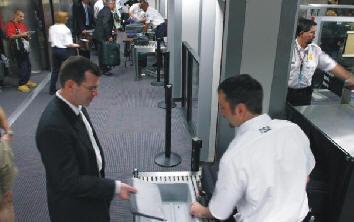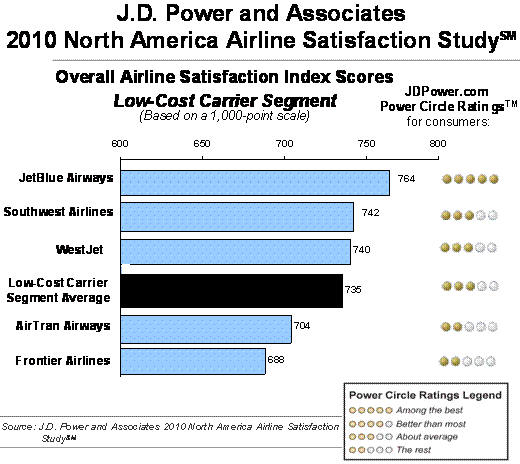|
|||||||||||
|
|
|
|||
|
By Mike Mitchell |
||||
 |
June 9, 2010 —
Reversing three consecutive years of declines, overall customer
satisfaction with airlines in “The fact that overall satisfaction with airlines has improved is particularly notable in light of a difficult economic year, in which add-on fees have continued to proliferate and two major airlines have merged,” said Stuart Greif, vice president and general manager of the global travel and hospitality practice at J.D. Power and Associates. |
|||
|
|
||||
|
According to Greif, many of the same macroeconomic conditions that adversely impact airlines financially—including lower fares—have led to improvements in satisfaction. For example, with fewer passengers traveling and fewer flights in the air, on-time performance has improved. As more airlines charge fees for checking bags, fewer passengers are choosing to do so, thus reducing the number of baggage issues and complaints. The study findings also suggest that while passengers may dislike add-on fees, they are gradually starting to accept them. In turn, those fees may be having a less pronounced impact on satisfaction as passengers recalibrate their expectations. “Airlines generally compete based on costs and fees, which is necessary to make their organizations stronger in an extremely difficult environment,” said Greif. “It’s important for carriers to remember, however, that building a base of committed passengers is also about creating a travel experience that fosters emotional attachment to a particular carrier, which in turn may make customers willing to flex their schedules or pay a little more for their flights.” |
||||
|
However, as the economy gradually recovers, airfares are beginning to rise and more travelers are returning to the skies. “The question is whether airlines will take the necessary steps to improve the passenger experience and build commitment before rising prices and increased passenger traffic negate those efforts.” said Greif.
The study
results include the following key findings:
• Overall, among
customers who are assigned to a middle seat, satisfaction averages 16
points lower than among customers in a window or aisle seat.
This impact is magnified among members of frequent flyer programs
of traditional network carriers, as satisfaction among these passengers
falls to 20 points below the segment average. In comparison, among
non-members of frequent flyer programs who are assigned to a middle
seat, satisfaction decreases to just two points below the segment
average.
• Among passengers
of traditional network carriers, 65 percent indicate that complimentary
meals are the in-flight amenity they would most like to have.
Approximately 56 percent of passengers of low-cost carriers say the
same.
• Nearly one-half
of passengers say that prices for in-flight beverages and food; checked
baggage; and preferred seating are unreasonably high.
• On average,
three in five airline passengers check baggage. Satisfaction with
boarding, deplaning and baggage averages nearly 60 points higher among
passengers who are not charged for the first checked bag, compared with
those who are charged for the first bag (765 vs. 702, respectively).
The 2010 North
America Airline Satisfaction Study measures customer satisfaction of
both business and leisure passengers with major North American carriers.
The study is based on responses from more than 12,300 passengers who
flew on a major North American airline between April 2009 and April
2010. The study was fielded between May 2009 and April 2010. |
|||||||||
| Other News Stories |
|||||||||
|
|
|||||||||
| ©AvStop
Online Magazine
Contact
Us
Return To News
|
|||||||||
|
|||||||||



